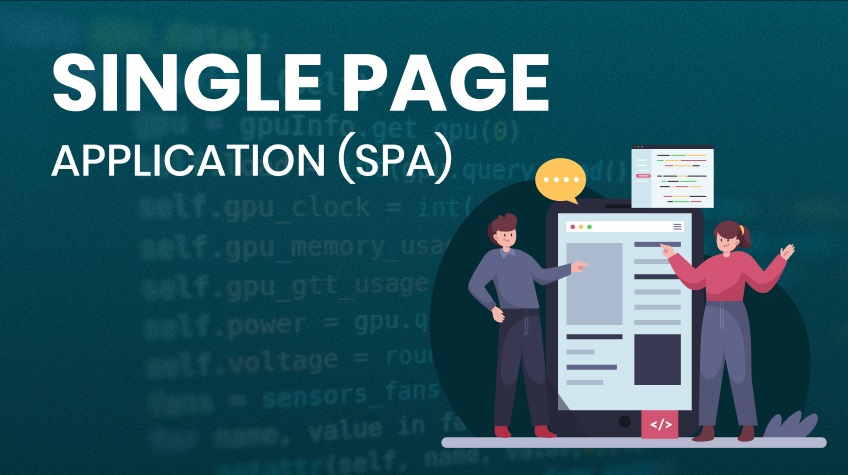
We live in a digitally powered world where we need access to data in real time to stay ahead at all times both in our personal and professional lives. Be it a retail store, e-banking app, the COVID-19 vaccine slot booking, etc, a website or an application can exceedingly help. Tasks that used to take long hours are only a few clicks away today. It is natural to explore the reason for their high efficiency and usability. Let’s dig deeper into this article to understand the single-page application in detail. This comprehensive guide will help you learn the uses, advantages, and security challenges of building a robust website using SPA. Let’s get started…
What Is a Single-Page Application (SPA)?
A single-page application, as the name suggests, is a single HTML page that does not require the user to navigate multiple pages. It dynamically updates only the relevant parts in the browser using JavaScript APIs in response to the user’s actions. However, when updating the content, it does not reload the entire website page from scratch. As a result, the user quickly gets real-time updates on the page content without refreshing.
The ability to provide a better user experience with features such as button clicks or field-level submissions makes the single-page application (SPA) a preferred choice among software developers. Developers in web development services in India use a manageable server space for their development as it does not require a much larger server space. They can easily launch SPA-based applications with tools like React and Angular.
SPA generally has an intuitive user interface and seamless architecture. The requirement for fewer pages to load or refresh ensures that the delivery time for updated content is consistently quicker. This way, it offers a smoother application experience to the user. Organizations can pair their backend development and frontend development using SPA. The single-page application also allows them to keep both backend development and frontend development separate. As a result, it improves the organizations’ operational efficiency with an improved user experience.
Some Common SPA Use Cases
SPAs offer strong advantages and ensure you reach your goal faster and smarter. Some popular use cases of SPA include:
- Social media networking sites (Facebook, Twitter, LinkedIn)
- Streaming services (Spotify, Netflix)
- Messaging apps (Gmail, Slack, Telegram)
- Real-time location sites (Google Maps, Uber)
- Project management tools (Trello, Jira)
- Other apps (Grammarly)
Let’s understand how some of the popular brands and platforms use SPA to improve user experience and enhance operational efficiency:
- Facebook: The Facebook page remains seamlessly accessible without reloading on each visit, thanks to the capabilities of SPA. The user experience on the social media platform remains seamless despite the changes in the URL.
- Gmail: SPA enhances Gmail’s approachability and responsiveness. It automatically updates the relevant content, ensuring a minimal delivery time.
- Google Maps: Another Google tool i.e., Google Maps, relies on the functionality of the SPA, which is handled within the browser. It dynamically updates the location when you scroll or click on a place marker instead of loading entire content from the server.
- Grammarly: With the efficient use of the SPA, Grammarly provides real-time grammar checks. It eliminates the need to reload or refresh the page, making it an easy-to-use writing platform. For this, it relies on the frontend framework called Vue.
- Netflix: Netflix demonstrates the superior efficiency and ideal long-term outcomes of the SPA. Even with the vast amount of data and content present on the site, the SPA ensures that the user’s experience is smooth and cohesive.
- Slack: The cloud-based messaging platform ensures faster real-time messages. This way, it allows remote teams to connect and collaborate on a project as a unified team. It uses ReactJS to ensure improved efficiency and faster delivery.
- Spotify: Spotify is yet another site that uses SPA. The single-page application or SPA uses the JavaScript API to create a unified user interface. This way, it manipulates Spotify data and enhances the feasibility of the overall Spotify web player.
- Trello: Have you ever wondered what makes Trello an instant responding service? The use of single-page applications ensures high-end performance as a collaboration tool. The easy user interface, seamless navigation, and real-time insight into the project’s milestones make it stand out in the competitive project management tools industry.
- Twitter: Twitter’s web development team often regards the site as a product of the modern SPA. The use of the React tool combines mobile device and website development experiences in one code. It makes sure users get real-time updates on their devices at all times.
Now that you have understood which popular global brands and platforms harness the power of SPI with unique frameworks, such as Angular, React.js, Vue, js, Aurelia, Backbone.js, Ember.js, Knockout.js, Meteor.js, and Polymer.js. Let’s explore its key benefits in the upcoming section. Here we go…
Benefits of Using SPA in Web Development
Here are some of the best benefits of SPA that make this HTML page a preferred choice among web developers. Take a look…
1. Instant Response and High Speed
Faster loading times make the Single-Page Application highly efficient and preferred for web development. Instead of refreshing the entire screen from scratch, it updates the content in real time. Therefore, famous websites (Netflix, Facebook, etc.) that get millions of views trust the SPA’s power.
2. Higher Stability
Often, SPAs access cache information to deliver faster results in response to the user’s actions. For this, it uses minimal bandwidth, ensuring you get the content even when the internet connection is poor.
3. Smooth UI
Single-page applications encourage user interactions by loading results quickly. Compared to a multi-page application, it ensures a better user experience, a higher engagement rate, and more organic traffic growth.
4. Easier to Debug
The SPA eliminates the need to read several lines of server code to test the software functionality. Developers easily debug SPAs by rendering JavaScript in the browser to find how it fetches information from the cache. Plus, they also detect bugs and glitches in the initial stage, ensuring no risk of the product’s failure before its launch.
5. Limited Server Resources
The SPA loads within the web browser only one time, eliminating the need to refresh or reload the page in response to every action. So, when the user clicks around to request an action, it does not send the information to the HTML. Instead, the server returns the requested data in a specific format, like JSON, to update the relevant information. This, in turn, reduces the need for server resources, ensuring both efficiency and readability at the same time.
6. Cross-Platform Support
Developers can use most of the server code to ensure cross-platform functionality. They allow a seamless transition from an SPA to a mobile application. The SPA is an efficient tool for scrolling. This makes it a great resource for developers when creating mobile-friendly applications. Plus, they integrate SPA to create highly efficient and readable web pages. Using SPA, developers can add various functionalities to web pages, including push notifications, local caching, and offline access.
7. Faster Development
Most importantly, SPAs use various APIs to allow developers a smooth and seamless software development. They can work on building the front end of the sites. This ensures faster product launches in the competitive market. Using modern JavaScript frameworks with SPA makes the development easier. They feature a lot of pre-built features like rich libraries, etc.
Some Popular Frameworks for SPA
Renowned websites or applications use frameworks with SPA to make the software more efficient and eloquent. Read on this section to understand which tools you should pair with API-enable technologies:
1. Angular
Developed and maintained by Google, Angular is a popular JavaScript framework. Currently, the most popular sites, such as Google, Forbes, Wix, healthcare.gov, weather.com, etc., use Angular. Simply put, the framework is highly responsive, with fast loading and smooth navigation.
2. React
Another framework that can be paired with SPA is React. Created by Facebook, React is a Javascript framework used to build seamless user interfaces (UI) and improve user experience (UX). Netflix, Uber, Reddit, Paypal, Walmart, Tumblr, Pinterest, and others use React.js in conjunction with the SPA.
3. Vue.js
Next very popular framework that web developers use is Vue.js. Launched in 2016, Vue is one of the most used frameworks for the efficient integration of the SPA. It helps developers build interactive user interfaces, ensuring intuitive and fast responsiveness. Renowned global organizations such as Alibaba, Nintendo, GitLab, Expedia, and Baidu are already using it.
4. Aurelia.js
Another framework that is used pretty often is Aurelia.js. Aurelia.js allows a broader integration with web platform specifications. For this, it uses convention over configuration with reduced intrusion time, ensuring a simple application setup. Also, it supports a number of JavaScript languages.
5. Backbone.js
Backbone.js is perfectly designed for smaller pages. This framework specifically ensures no data binding. Therefore, it performs faster when working with smaller datasets and offers an optimal performance.
6. Ember.js
Another framework that is widely used with SPA is Ember.js. It is highly efficient and useful for complex HTML and supports flexible projects. The best thing about Ember.js is that it can handle backend architecture separately. This makes it compatible with enterprise-level software and applications.
7. Knockout.js
The next framework that works great with SPA is Knockout.js. For those who prefer a minimalist JavaScript framework for efficient web development, knockout.js is the best option. It is a widely accepted framework because it is compatible with every type of client-side and server-side technologies.
8. Meteor.js
Another framework that is highly preferred and is considered best for naive developers is Meteor.js. It consists of tools and packages to make the tool’s usage efficient for everyone. Most importantly, it produces cross-platform code with fast and efficient prototyping.
9. Polymer.js
Developed by Google and GitHub expert developers, the Polymer.js framework ensures you can build reusable components for the HTML framework. Notably, it uses CSS for designing web developments along with others.
Now is the time for the most important question: When should you use SPA in web development?
If you don’t yet, then read on the next section for the detailed answer.
When Should You Use SPA for Web Development Process?
Web development service provider in USA should be aware of the use cases of SPA. Understanding its applications can greatly enhance the web development process. Take a look at the pointers mentioned below to understand when to use SPA for web development:
SITUATION 1: When Your Objective is to Offer Excellent User Experience
If you want to design a website or application that promotes user experience with minimum loading time, then SPA is your best bet. Consider making the best use of the efficiency and usability of SPA for your project work. It helps maximize user experience, ensuring no delay in response to the user’s request.
SITUATION 2: When Developing Apps for Fast and Smaller Platforms
If you do not have a large dataset to handle, prefer the integration of single-page applications to boost the brand’s visibility. With efficient management and monitoring of small datasets in real-time, it does not put a heavy load on the website. This way, it ensures higher accessibility and faster responsiveness.
SITUATION 3: When It’s About Client-Side Functionality
Remember, a higher level of the user’s satisfaction ensures the success of any website or application. Building the website with SPA ensures a user-intuitive interface that features rich client-side functionalities.
SITUATION 4: When Implementing Unique Brand Storytelling Strategy
If your objective is to increase organic traffic with a brand storytelling strategy, consider utilizing SPA for the purpose. It is a great platform to promote the product or service with online storytelling. This way, it helps people connect to your brand in a shorter time.
Security matters, and here is how to use SPA securely. Read on!
How to Use SPA Securely?
Undoubtedly, SPAs make web development a cakewalk for developers. Developers can utilize this tool to build robust online platforms more quickly. However, it is crucial to know that some security flaws make it a vulnerable tool for cyber attackers. If you are thinking of developing a website with SPA, you’ll need to follow some security strategies to prevent the threat of cyberattacks. So, leverage the power of HTTPS and establish proper security authentication headers to safeguard the process. Furthermore, check out the following pointers:
- Limit the access of user sessions with API calls
- The user session should span between 5 and 15 minutes
- Integration of use access tokens that hide important information like personally identifiable information
- Use token handler security methods to minimize data storage, processing, and transmission.
These tips will help you develop websites or applications mindfully without having to worry about cyber threats.
In a nutshell
So, this is all about the Single-Page application (SPA). In this age and time where everything is digitalized, SPA (Single-Page Applications) plays a crucial role. Implementing this tool into web development can make the task easier and allow you to create stunningly impressive websites or applications.
Remember that a good site or app can help an organization improve its bottom lines. And SPAs come in handy in such a situation. However, you should be vigilant with security concerns while using Single-page application for web development. By designing robust SPA platforms, you can enhance the user’s satisfaction. Thanks for reading! Hope this article has been informative for you and helped you use SPA more diligently!






